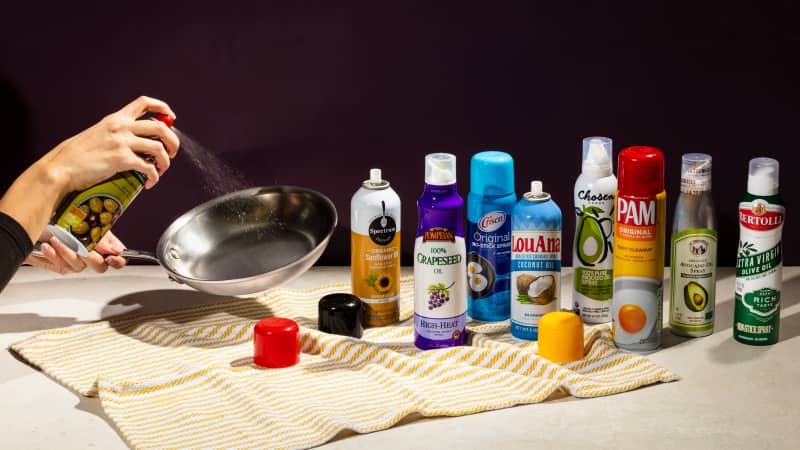The Best Baking Sprays
Taste Test
This handy product can be the difference between a successful dish and a sticky disaster. Which one you use matters.
Published Apr. 10, 2023.

Cooking spray comes in handy in the kitchen. It can be used for coating a skillet before frying eggs or sautéing vegetables or for spraying sheets of aluminum foil before covering lasagnas, casseroles, and salmon to ensure the foil doesn’t stick to the food. It is helpful for preparing muffin tins and cake pans so that baked goods turn out cleanly. We’ve found that it can even be used to grease a measuring cup to ensure sticky ingredients slide out easily.
For years, cooking sprays were typically made with canola oil, but now you can find products made with coconut oil, avocado oil, olive oil, and more. To find the best cooking spray we cast a wide net, evaluating sprays made from various oils. Regardless of the type (or types) of oil used, the cooking sprays in our lineup fall into two main categories: traditional (with propellants) or bag-on-valve (also referred to as propellantless).
We didn’t see a performance or flavor difference with different types of oils in our testing lineup, but between the two styles, there was a lot to learn, with benefits and drawbacks to each. Read on to find out which is best for you.
What’s in the Can? Traditional cooking sprays typically consist of one or more oils combined with a propellant such as propane or butane. Under pressure, these propellants are liquids, but when the valve is released, they turn to gas and expand, propelling the oil out of the can as the propellant dissipates into the air.
Spray Pattern: The traditional cooking sprays all had similar nozzles and oil-channel shapes. They dispersed spray in a circular pattern, which we liked because this pattern more efficiently covered the surface of our pans. This spray pattern can be attributed to the shape of the channel the oil travels up before being expelled. Another key design element: The spout was angled straight ahead, so the spray shot straight too. This meant that we knew exactly where the spray was going to land—a big help in evenly and efficiently coating our pans. Lastly, brands with antifoaming agents such as dimethyl silicone also sprayed more evenly.
Nonstick Ability: Most traditional cooking sprays contain emulsifiers, such as lecithin, to improve performance. Lecithin helps oil adhere to the surface of cookware or bakeware. Cooking sprays containing it created absolutely seamless nonstick surfaces. Neither chicken breasts nor fried eggs stuck to a stainless-steel skillet. The Bundt cake we baked in an intricately patterned pan released like a dream, leaving barely a crumb behind.
Smoke Point: However, there is a drawback to lecithin. Lecithin has a low smoke point, so sprays containing it...
The mission of America’s Test Kitchen Reviews is to find the best equipment and ingredients for the home cook through rigorous, hands-on testing.

Carolyn is a senior editor for ATK Reviews. She's a French-trained professional baker.
This is a members' feature.
0 Comments